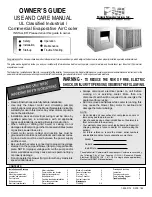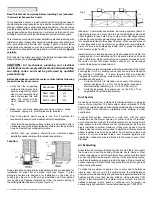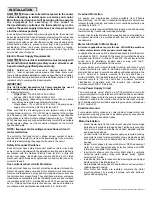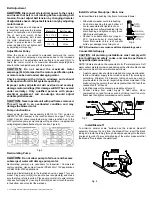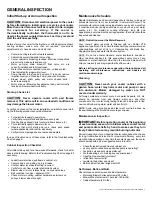
CORRECTIVE ACTION:
1. Check power supply
A. Replace fuse*
B. Reset breaker*
2. Adjust or replace belt
3. Replace motor
A. Adjust belt tension or replace
B. Lubricate or replace bearings
C. Adjust motor sheave to obtain motor
nameplate full load amps*
D. Call electrician
1. Open relief vents to increase exhaust
2. Adjust motor sheave to obtain motor
nameplate full load amps
3. Adjust belt tension or replace
1. Open relief vents to increase exhaust
2. Adjust to direct airflow as required
3. Check water distribution system
A. Replace pads
B. Repack pads
C. Clean troughs, unplug holes
D. Clean or replace pump
E. Check for leaks and correct
F. Clean or replace distributor
G. Clean or replace bleed-off
H. Clean basket
1. Adjust belt tension
2. Lubricate bearings, replace if needed
3. Correct motor sheave adjustment DO
NOT exceed motor nameplate amps*
4. Check and correct alignment
1. Adjust float
2. Replace float valve
3. Tighten standpipe (hand tight)
1. Lubricate or replace bearings
2. Re-center wheel in housing
3. Inspect wheel, replace if necessary
4. Inspect blower components, tighten
1. Inspect and adjust, replace as required
1. Open relief vents to increase exhaust
1. Drain, clean and flush reservoir
2. Check bleed-off, replace pads
3. Turn pump ON for several minutes
prior to starting cooler
PROBLEM / SYMPTOM:
Units fails to start or deliver air
Unit starts, air delivery
inadequate
Inadequate cooling
Motor cycles or fails to operate
Water draining from unit
Knocking or banging sound
Blower shakes or rattles
Excessive humidity inside
Musty or unpleasant odor
POSSIBLE CAUSE:
1. No electrical power to unit
A. Fuse blown
B. Circuit breaker tripped
2. Belt loose or broken
3. Motor overloaded and/or frozen bearings
A. Belt too tight or broken
B. Blower wheel bearings dry / frozen
C. Motor overloaded
D. Inadequate wiring, non-functional
breaker or motor starter
1. Lack of adequate air exhaust
2. Motor under loaded
3. Belt too loose
1. Inadequate exhaust from building
2. Air registers / diffusers improperly set
3. Inadequate water supply / pad not wet
A. Pads clogged
B. Dry or open spots on pad
C. Trough holes / slots plugged
D. Pump not working
E. Loose connections in water system
F. Distributor clogged or corroded
G. Inadequate bleed-off (pads clogging)
H. Pump basket clogged
1. Excessive belt tension
2. Blower shaft tight or frozen
3. Motor overloaded
4. Pulleys mis-aligned
1. Float arm improperly set
2. Seat in float valve leaking
3. Standpipe not tight
1. Bearings dry
2. Wheel rubbing blower housing
3. Rotating off-balance
4. Loose parts
1. Belt or pulley loose
1. Inadequate exhaust from building
1. Stale or stagnant water in cooler
2. Pads clogged or mildewed
3. Pads not completely wet before
starting blower wheel
Troubleshooting:
The following guide is intended to help you diagnose and fix some of the most commonly encountered problems; by no means does this
guide cover all of the possible problems you may encounter. If you cannot diagnose and correct the problem, or if it persists, contact
qualified service personnel. All electrical work should be done by, or with the help of, a qualified electrician.
8 UL Classified Industrial / Commercial Evaporative Cooler Use and Care Manual
* - If condition persists, call electrican

